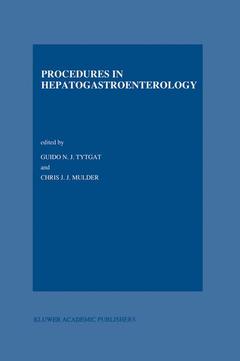Description
Procedures in Hepatogastroenterology, Softcover reprint of the original 1st ed. 1997
Developments in Gastroenterology Series, Vol. 15
Coordinators: Tytgat G.N., Mulder Chr.J
Language: English
Subjects for Procedures in Hepatogastroenterology:
Keywords
AIDS; endoscopy; gastroenterology; gastrointestinal tract; shock; surgery
Publication date: 10-2012
495 p. · 16x24 cm · Paperback
495 p. · 16x24 cm · Paperback
Description
/li>Contents
/li>Comment
/li>
Endoscopy has revolutionized clinical gastroenterology. In 1961 Basil Hirschowitz published the first flexible endoscopic examination of the stomach and duodenal bulb. We moved from flexible fiberendoscopes to current video-endoscopic equip ment. Current video-endoscopes incorporate a black and white or color 'chip' at the tip of the instrument which transforms the visual image into electronic signals. The size of the pincet is constantly getting smaller, heading for 5 /Lm, further increasing the resolution. The signals are reassembled into high-quality color images in a video monitor. Endoscopes are now used to examine the entire gastrointestinal tract from esophagus to rectum, including the biliary and pancreatic ductal system. Targeted endoscopic biopsy offers rapid and precise diagnosis. Endoscopic ultrasonography is of unsurpassed accuracy in staging gastrointestinal tumors, in assessing pancreatic and biliary disease, and disorders of the rectum and anal canal. Moreover, targeted cytological sampling is possible of abnormalities of the intestinal wall or peri intestinal lymph node. Yet despite these glamorous achievements changes are to be expected in the overall emphasis of diagnostic endoscopy. Magnetic resonance cholangiopancreatography may very well compete for a substantial fraction of diagnostic ERCP. Virtual colonoscopy or computed tomographic colography may well compete with (and take over?) screening/surveillance colonoscopy.
Preface. Section I: Endoscopy of the Upper Part of the Gastrointestinal Tract. Section II: Endoscopic Retrograde Cholangiopancreatography. Section III: Hepatobiliary Investigation. Section IV: Endoscopy of the Lower Part of the Gastrointestinal Tract. Section V: Endoscopy in Childhood. Section VI: Endosonography. Section VII: Endoscopes. Section VIII: AIDS. Section IX: Intervention Therapy with Laser, APC and Electrosurgery. Section X: Shock Wave Therapy. Section XI: Endoscopy Unit. Index.
This volume covers the new developments in the techniques, indications and complications in gastrointestinal endoscopy, both diagnostic and therapeutic. It is a completely rewritten and updated edition of the first edition, which was published in 1993. The book is aimed at all doctors and nurses involved in hepagastroenterology.
© 2024 LAVOISIER S.A.S.




